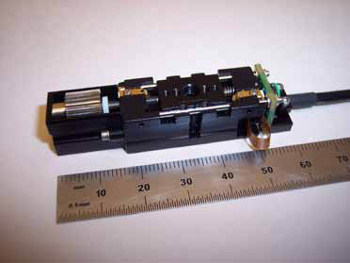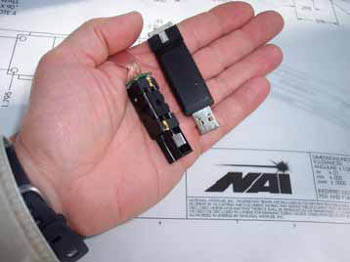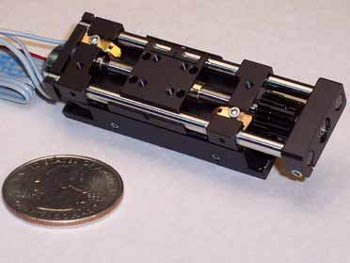 |
| April 17, 2012 | Volume 08 Issue 15 |
Designfax weekly eMagazine
Archives
Partners
Manufacturing Center
Product Spotlight
Modern Applications News
Metalworking Ideas For
Today's Job Shops
Tooling and Production
Strategies for large
metalworking plants
Tiny but mighty: Mini positioning stages offer micron-level accuracy
Compact, reliable servo motors yield rotary and linear stages for demanding scientific and medical applications.

Location, location, location. It's not only the mantra of real estate agents, it's what positioning is all about, especially when it comes to scientific applications.
Tabletop devices for lab automation, instrumentation, biotech, and semiconductor manufacturing require precise, repeatable, and highly accurate motion control. But researchers and OEMs want to focus on completing their experiments or building their instruments, not on becoming motion specialists. That's where National Aperture comes in. The company produces a range of miniaturized linear and rotary positioning stages capable of micron-level accuracy and submicron repeatability – with the help of compact servo motors from MICROMO.
In sharp contrast to the dust, heat, and even caustic chemicals that industrial motion control systems must endure, the cool, clean environment of a typical lab or cleanroom seems like it should make automation easy. Far from it. What a typical scientific application lacks in environmental challenges it makes up for in terms of performance demands.
They may not take place on a hot, dirty factory floor, but applications like DNA testing or flip-chip bonding require spatial positioning on the order of microns, not millimeters. Motion needs to be carefully controlled to produce reliable, duplicable results. The systems must produce repeatable action, even when subjected to the heavy-duty cycles that commercial labs can impose. As if that isn't enough, they need to provide all of that performance in the smallest possible package.
Tiny but mighty
High spatial resolution in a small form factor is National Aperture's specialty. When the company's engineering team set out to build a line of miniaturized devices, they wanted to design linear stages capable of achieving micron-scale accuracy with kilogram-level loads and rotary stages with sub-100-arcsec accuracy.

To meet size and performance requirements, the motors powering the stages needed to be no more than 13 mm in diameter and provide consistent performance. The most accurate, repeatable stage in the world is useless unless it can carry the load required, however. The challenge for the National Aperture design team was finding sufficiently small motion components that could produce not only the consistency but the torque needed, while ensuring the kind of reliability scientific applications require. MICROMO, the North American value-added distributor for the Faulhaber Group, provided the answer.
The motor packages consist of precious-metal commutated servo motors operating at high enough speed that they can be integrated with planetary gearheads to increase torque and still achieve the desired motion characteristics. The subassembly also includes an optical encoder to ensure accuracy. Currently, the linear stages can position loads up to 3 kg with ±0.5 μm repeatability and a linear accuracy of ±1.0 μm per 25 mm of travel. The rotary stages can carry 2-kg axial loads with 80-arcsec accuracy and 15-arcsec repeatability. Of course, it is important to remember that accuracy and repeatability numbers increase as reduction ratio rises.
Although National Aperture offers standard products, where they really excel is in tailoring their motion platforms to meet the specifications of a project. "We look at the customer's application, and then we build to meet his need, depending on the load, the speed, or the torque requirements," says William Grenier, president and general manager of National Aperture. He gives MICROMO credit for that flexibility. "MICROMO offers a good variety of gearheads with different gear ratios. They have a very small footprint and very high accuracy."
At 13,000 rpm, the motors offer sufficient speed to allow engineers to choose the best gearhead for the job. Sometimes achieving torque and speed targets is straightforward; sometimes it requires a balancing act. It's a matter of defining a priority between the two. "We can come up with the torque the customer requires," Grenier says. "He may have to give a little bit on speed because of the gear reduction, but we're usually able to come to a happy medium."
Beating backlash
One barrier to both positioning accuracy and speed is backlash. For ultra-high-performance applications, National Aperture adds an anti-backlash nut to damp stage motion at the end of run. Here again, there are tradeoffs involved. The anti-backlash nut improves accuracy and repeatability, but it also adds friction, which means the reduction ratio must be increased to provide more torque. Of course, extra torque only comes at a price. The standard speed of the stages is 6 to 12 mm/sec; with the switch to a 64:1 gearmotor, for example, the speed drops to 1.65 mm/sec.
It falls to the user to determine whether positioning performance or speed is more important. "It's a tradeoff," says Grenier. "If they need the accuracy and the repeatability, they can usually live with a slower speed. On the other hand, no matter what your speed is, if you can't give them the repeatability and accuracy, it's no good at all."
The anti-backlash nut approach is designed in from the beginning of production, not adjusted on a per-part basis. For the damping mechanism to be effective, the motors need to be consistent from device to device, especially in velocity and torque. "Our anti-backlash nut comes after the motor and the gearhead, so naturally if the motors are not consistent then [the effect of] our anti-backlash nut would vary," says Grenier. "MICROMO's products are very consistent, and that helps us."

Smaller components, new capabilities
Sometimes even a modified version of the standard platforms won't fit the bill. In those cases, National Aperture will customize a product to meet user needs. "If it looks like the right project, we'll work with the customer and MICROMO to develop something for them," he says. One example is an ultra-compact stage offering 5 mm of travel. Although National Aperture offered such performance in a manual stage, they had previously been unable to build a sufficiently compact and accurate motorized version with the motors available. That changed when MICROMO released its 6-mm PA2-50 encoder. In combination with the company's 6-mm gearmotor, it provided the required performance. "Those two things together really gave us what we wanted," says Grenier. "The 6-mm motor includes gearhead, motor, and everything. With a very high resolution encoder, it really made the package very accurate."
In order to meet the stringent size constraints of the new device, MICROMO customized the gearmotor assembly in its dedicated machine shop, combining motor and leadscrew to reduce footprint. The result is the MM-1M motorized MicroMini stage, which offers ±3-μm accuracy and ±2-μm repeatability over 5 mm of travel. Not only did it satisfy the requirements of the application, it is now part of the National Aperture product line, with the blessing of the OEM. It's not the first time National Aperture and MICROMO have collaborated, and it won't be the last. "I've found MICROMO to be extremely easy and willing to work with us [on custom projects]," Grenier says.
National Aperture's MicroMini stages show up in labs around the world, as well as in instruments like spectrometers, chemistry analyzers, microscopes, and optical systems. To maintain customer satisfaction, not to mention cost of returns and reworks, the company needs reliable motion systems powered by MICROMO's reliable components. "We hardly ever have a motor failure," says Grenier. "Long term, the motors are extremely reliable." And so, he says, is the company. "They're very good at delivery; they have a very good quality product. We've been very satisfied with MICROMO."
Want more information? Click below.
MICROMO
Published April 2012
Rate this article
View our terms of use and privacy policy
